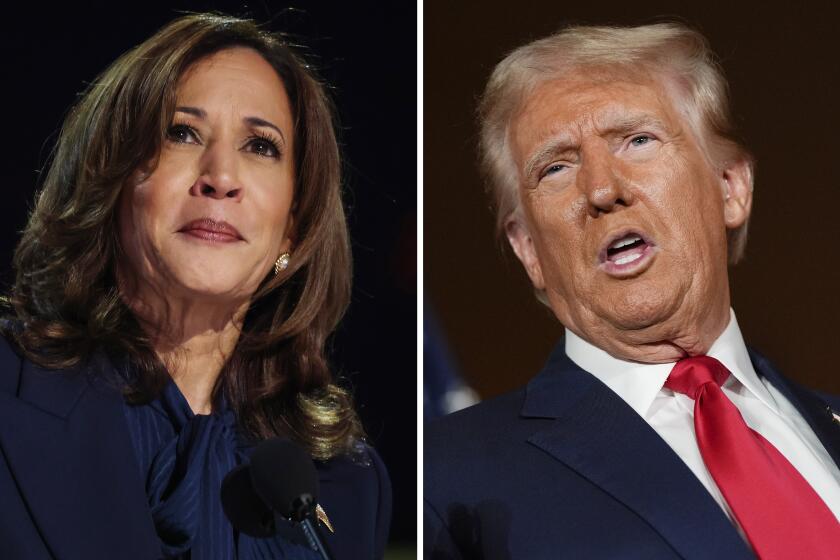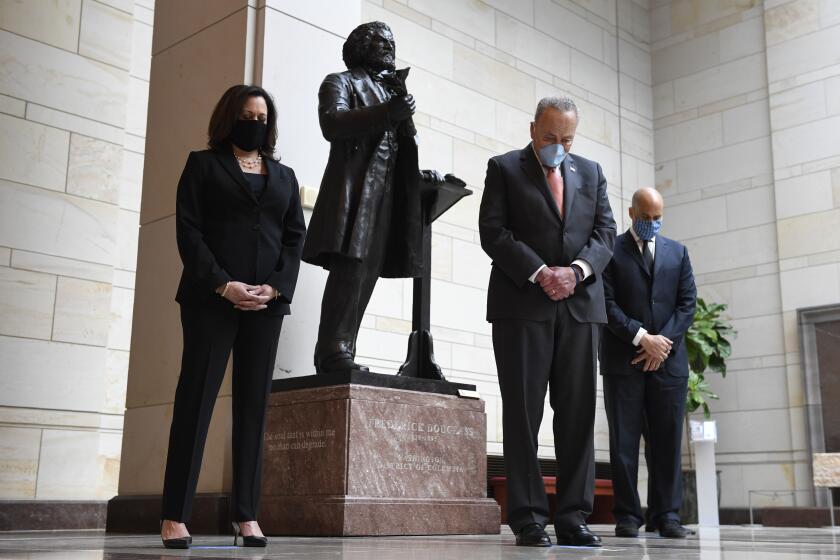Schwarzenegger’s golden opportunity
FEW GOVERNORS have been in as powerful -- and enviable -- a position to shape California’s future growth as Arnold Schwarzenegger. He is the most popular governor since Earl Warren and has more money to spend on rebuilding projects than anyone since Pat Brown, thanks to last year’s passage of $40 billion in bond measures.
The governor also has a bold environmental plan to reduce greenhouse gas emissions in the state by 25% over the next 13 years. But, as his advisors acknowledge, Schwarzenegger cannot meet this target without rethinking the ways in which California grows. Fortunately, the bond money opens up unique opportunities for him to steer development in new directions. If he fails to capitalize on this chance to re-imagine California’s growth, Schwarzenegger won’t reach his greenhouse gas goal -- and the state’s future prosperity will be threatened.
The landmark climate change bill passed in September and signed by Schwarzenegger should be the foundation of a new vision. But that vision should go far beyond simply ramping up recycling and driving cleaner cars on the so-called hydrogen highway. It also should include ideas on how to level off the amount of driving in California. Among other things, that means building more affordable housing closer to where people work. That would increase densities in many urban areas, but, if done correctly, it also would help multiply travel options -- rail, bus and foot -- and lower the overall time people spend in their cars.
California is choking on traditional suburban tract-style growth. The cost of housing is among the highest in the country. The population continues to grow by about 500,000 people a year. The coastal metropolitan areas -- Los Angeles, San Diego, Santa Barbara and San Francisco -- have run out of land for further development, and sprawl in the inland areas -- Riverside, San Bernardino and the San Joaquin Valley -- is largely unchecked. Doling out bond money to perpetuate a 1970s vision of development won’t alleviate any of these problems. But linking the bond money to new development patterns will.
Schwarzenegger’s climate action team, which drew up the road map for implementing the climate change initiative, predicts that 18 tons of the planned reductions in emissions will have to come from changes in California’s growth patterns. (The initiative would cut greenhouse gas emissions from the state’s factories, utilities, refineries and other industrial sites by 170 tons overall.) That’s the second-largest single source of greenhouse gas reductions in the governor’s plan, behind only tighter vehicle emissions standards. It’s double the target for reduction in hydrofluorocarbons spewed by the state’s privately owned utility plants.
History suggests that changing development patterns is critical here. For almost 40 years, the near-miraculous decrease in tailpipe emissions in California has been offset by residents driving more. Technology alone won’t solve the problem.
The climate action team assigns the task of redirecting the state’s growth to the secretary of business, transportation and housing. Unfortunately, the job is vacant because of the recent departure of Sunne Wright McPeak.
Ordinarily, state government does not directly control how California grows because counties and cities make most real estate development decisions. But the state does “set the table” for growth through spending decisions, especially on transportation projects.
To meet his emissions reduction goals, Schwarzenegger will have to use the bond money to stimulate or reinforce certain kinds of growth. For instance, he should encourage more building in already developed urban areas along the lines of that occurring in Pasadena and Santa Monica, where three- and four-story real estate projects put residences, offices and stores under the same roof. (Los Angeles Mayor Antonio Villaraigosa call this approach “elegant density.”)
The governor also should provide incentives for business to create more jobs near the housing-rich suburbs in the Inland Empire and the Central Valley. That way, people pursuing the traditional American dream would not have to spend hours driving to their jobs in coastal cities.
Half the bond money -- the $20 billion in Proposition 1B -- will pay for transportation projects. About $1 billion of this is earmarked for upgrading California 99 in the Central Valley, but there are no other specific projects mandated. Schwarzenegger thus has a wide berth to direct this money to encourage the kind of growth that will help him achieve his climate change goals. Transportation projects, whether highway, rail or bus, always determine where development goes. Spending money to alleviate congestion is important. But reductions in greenhouse gases can only occur if the overall amount of driving in the state significantly drops. The governor should use the bond money to get people out of their cars.
Schwarzenegger could get even more bang for the buck if he used funds from the different bonds in tandem. For instance, Proposition 1C -- the housing bond -- sets aside $850 million for building projects in already developed areas and $300 million for projects close to rail stations or stops along rapid bus lines, such as in Orange County and the San Fernando Valley. To the governor’s great advantage, he has the opportunity to target the locations and projects that would make a big difference. For instance, the housing money could subsidize new, higher-density residential complexes near transit stops -- and the transportation money could be spent to improve service on the adjacent rail or bus lines.
The governor even has a great opportunity to use Proposition 84, the $5.4-billion water/parks bond, to reinforce his vision. Although he has less say in how this money is spent because the initiative names specific projects, his administration controls some funds. He could facilitate the realization of his transportation and housing goals by using Proposition 84 money to buy land -- in the foothills of the western Sierras, for instance -- that would otherwise be developed for long-distance commuters.
For Schwarzenegger to succeed, he will have to take on his building industry supporters on the one hand, and probably his environmental supporters on the other. The builders don’t want him to restrict their ability to build where they want, and the environmentalists don’t want him to encourage new growth. But if the governor is serious about meeting his own greenhouse gas reduction goals, he’s going to have to take on at least some of these interest groups and promote an alternative approach to growth. It’s unlikely that he -- or any future governor -- will ever have this much money and this much leverage again.
More to Read
Get the L.A. Times Politics newsletter
Deeply reported insights into legislation, politics and policy from Sacramento, Washington and beyond. In your inbox three times per week.
You may occasionally receive promotional content from the Los Angeles Times.










